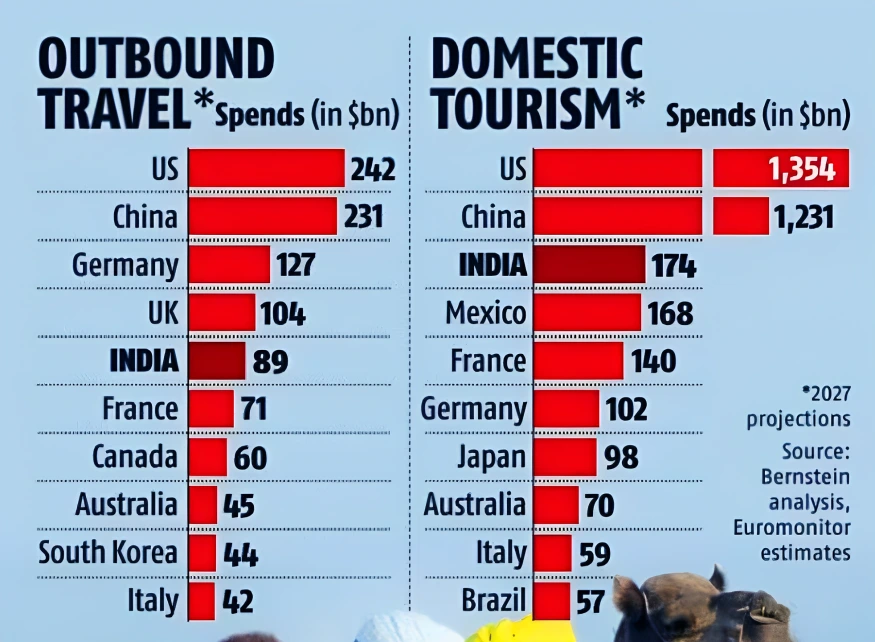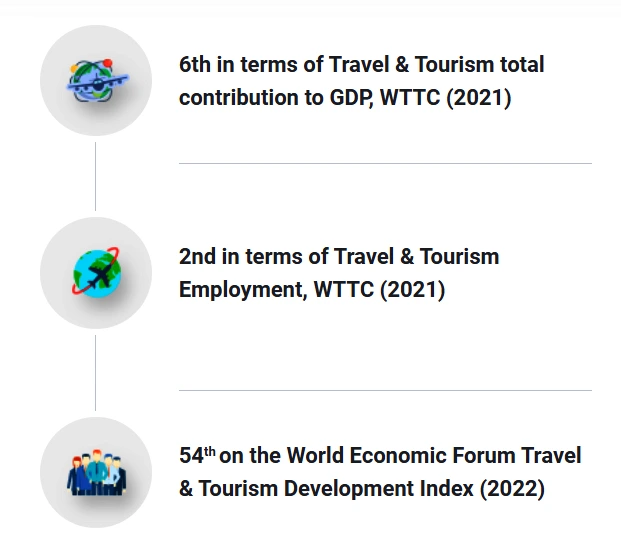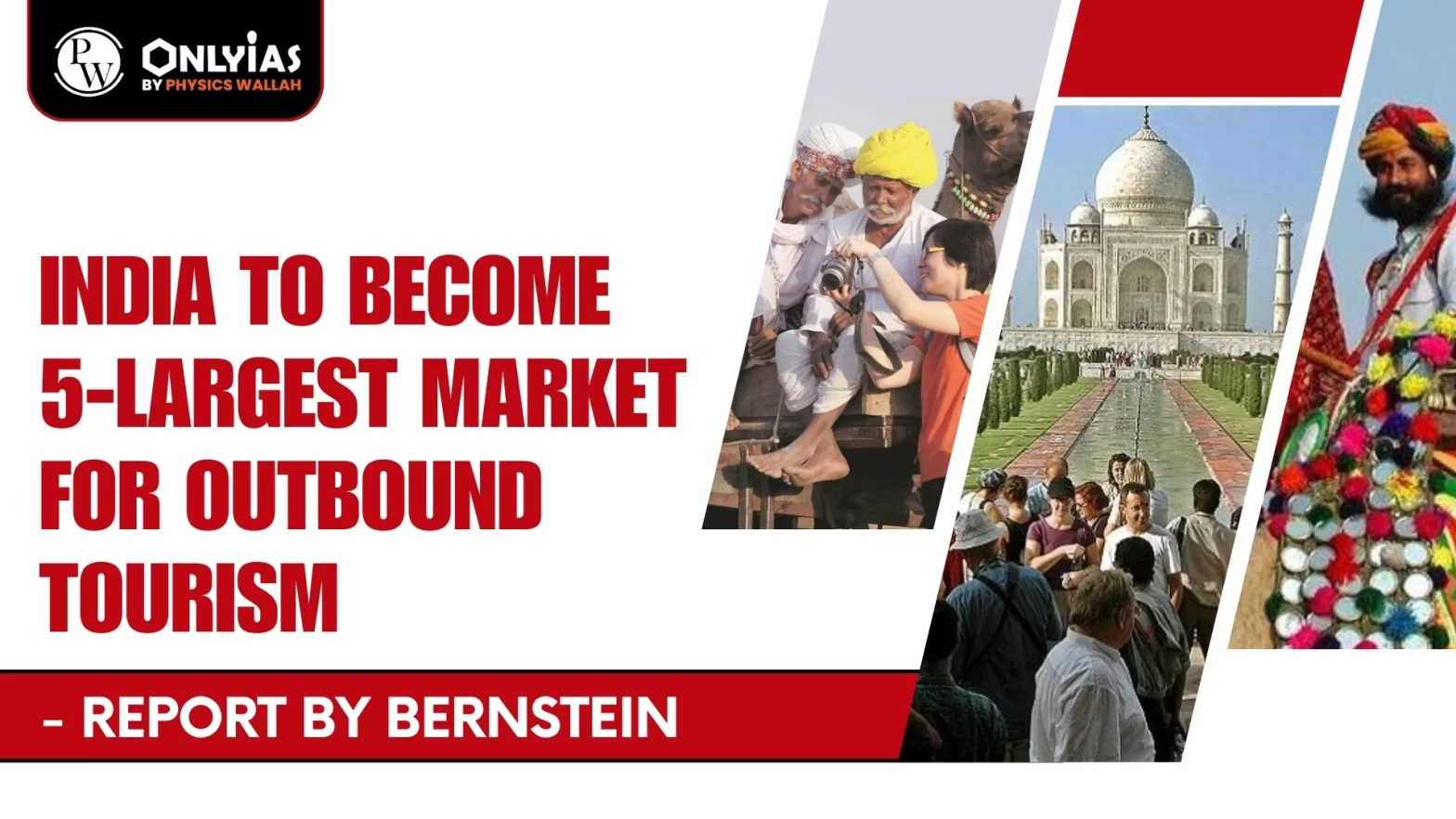Context: This article is based on the news “India on course to become 5th-largest market for travel and tourism” which was published in the Business Standard. According to a report by Bernstein, India is ready to become the next big travel market in the world, projected to hit the 5th rank in outbound tourism with spends of $89 billion in 2027 as compared with the current 10th position with $38 billion in 2019.
| Relevancy for Prelims: Outbound Tourism, Indian Tourism Industry, World Tourism Organization (WTO), World Travel & Tourism Council (WTTC), G20 summit, and UNESCO World Heritage Sites In India.
Relevancy for Mains: Indian Tourism Industry; Current status, Strengths, Weaknesses, and Way Forward. |
India’s Outbound Tourism Doubles in Three Years
- Tourist Inflows: India is projected to become the 3rd largest domestic market by 2027 with spending of $174 billion, up from the $127 billion spent in 2019 when it was in fifth place.
- This places India behind only the USA and China, and ahead of Brazil, Italy, Australia, Japan, Germany, France and Mexico.
- Outbound Tourism: Of the total travel share, outbound tourism has gone up from 17% in 2019 to 32% in 2022.
- India will be behind only the US, China, Germany and the UK, but ahead of Italy, South Korea, Australia, Canada and France, to name a few.

- Domestic Tourism: Travel is concentrated in just 5 states that account for 65% of the footfall.
- These include Tamil Nadu followed by Uttar Pradesh, Andhra Pradesh, Karnataka and Maharashtra.
Also Read: World Tourism Day 2023 – Theme, Significance, and More
What is the current status of the Indian Tourism Industry?
- Tourist: The World Tourism Organization (WTO) defines tourists as people “traveling to and staying in places outside their usual environment for not more than one consecutive year for leisure, business and other purposes
- India’s travel and tourism sector: According to the World Travel & Tourism Council (WTTC), in 2022, the contribution of India’s travel and tourism sector to India’s economy was worth Rs 15.7 trillion. By the end of this year, it would be worth Rs 16.5 trillion.
- The travel market in India is projected to reach US$ 125 billion by FY27 from an estimated US$ 75 billion in FY20.
- Tourist Arrivals in India: As per the Ministry of Tourism, Foreign Tourist Arrivals (FTAs) during the period January-March 2023 were 25,29,766 as compared to 7,84,750 in January-March, 2022 registering a growth of 222.4%.

What are the strengths of the Indian Tourism Industry?
- High Population with Increasing Wealth: According to Bernstein, the strength of Indian tourism industry lies in the fact that it is the most populous country in the world with 80% of Indians below 50 years and the increasing wealth of one-third of the population as it moves to middle and high incomes by the middle of this century.
- Robust Demand: The travel market in India is projected to reach US$ 125 billion by FY27 with the international tourist arrivals expected to reach 30.5 million by 2028.
- Attractive Opportunities: India offers a variety of experiences, including 40 UNESCO World Heritage sites, archaeological remains of ancient civilizations, wildlife in national parks and sanctuaries, the world’s highest mountain ranges, expansive beaches, the magnificent desert and a rich cultural heritage.
- The Ministry of Tourism designated 2023 as the ‘Visit India’ year when more than 60 cities hosted more than 220 meetings (for the G20 summit).
- Policy Support: US$ 289.89 million allocated to the Ministry of Tourism as the sector holds huge opportunities for jobs and entrepreneurship for youth.
- an outlay of US$ 170.85 million has been allocated for the Swadesh Darshan Scheme.
- Government Initiatives: The Indian government has undertaken initiatives to promote tourism, such as the “Incredible India” campaign. Additionally, policies and reforms have been implemented to ease visa processes and encourage foreign investment in the tourism sector.
- Other Initiatives:
- Tourist Visa on Arrival (VoA) enabled by Electronic Travel Authorization (ETA) has been introduced for the citizens of 43 countries, simplification of procedures for classification of hotels and restaurants, improving infrastructure development, identification and improving major tourist circuitse etc.
- Translating of ministry’s promotional website www.incredibleindia.org in various languages including Chinese, Arabic, French, German, Korean, and Japanese languages to further position India as a leading tourist destination.
What are the weaknesses of the Indian Tourism Industry?
- Infrastructure Challenges: Despite improvements, certain regions in India still face challenges related to infrastructure, including transportation, roads, and public facilities. Inadequate infrastructure can affect the overall tourist experience.
- The Travel and Tourism Competitiveness Index 2021 ranks India 54th out of 141 countries overall and it mentions that some aspects of India’s tourism infrastructure remain somewhat underdeveloped.
- For example, the nation has very few hotel rooms per capita by international comparison and low ATM penetration.
- Safety and Security Concerns: Ensuring the safety of tourists is crucial for the industry’s growth. Safety concerns, including instances of crime and harassment, can impact the perception of India as a tourist destination.
- India faces many security risks due to which it was placed 41st for safety out of the 42 most popular countries for travelers in the World’s Safest Countries rankings in 2022, produced by Berkshire Hathaway Travel Protection. Lack of Connectivity to Remote Areas: As the tourism industry is closely integrated with several other industries like hotel and accommodation, aviation, railway, roadways, healthcare, entertainment, etc., the combined weaknesses of all the sectors make it more vulnerable.
- The aviation sector and network of trains with buses and taxicab services, all these systems work independently, often resulting in long waiting hours and creating a confusing situation for the tourist.
- Environmental Impact: Over-tourism in certain areas can lead to environmental degradation and strain on natural resources.
- In recent years, Uttarakhand has encountered an issue of overcrowding.
Way Forward
- Tourism Friendly Infrastructure: Invest in improving integrated transportation networks, including roads, airports, and railways, to enhance accessibility to tourist destinations.
- Upgrade and expand accommodation facilities, ensuring diverse options to cater to different traveler preferences and budgets.
- Diversification of Tourism Offerings: Explore and develop niche tourism segments such as adventure tourism, wellness tourism, and cultural experiences to attract diverse travelers. Promote lesser-known destinations to distribute tourist traffic and benefit local economies.
- Government Policies and Support: Implement policies that facilitate ease of travel, such as providing incentives for tourism-related businesses. Collaborate with the private sector and local communities to create an enabling environment for tourism development.
- The industry is also looking forward to the expansion of the e-Visa scheme, which is expected to double the tourist inflow in India.
- India’s travel and tourism industry has the potential to expand by 2.5% on the back of higher budgetary allocation and low-cost healthcare facilities according to a study conducted by Assocham.
- Marketing and Promotion: Develop and implement effective marketing strategies to promote India as a premier tourist destination. Leverage digital marketing platforms and social media to reach a global audience and engage with potential travelers.
Conclusion:
Indian tourism industry shows immense potential for growth, with rising outbound tourism, increased domestic spending, and strategic initiatives, yet challenges like infrastructure and safety must be addressed for sustained success.
![]() 8 Dec 2023
8 Dec 2023



